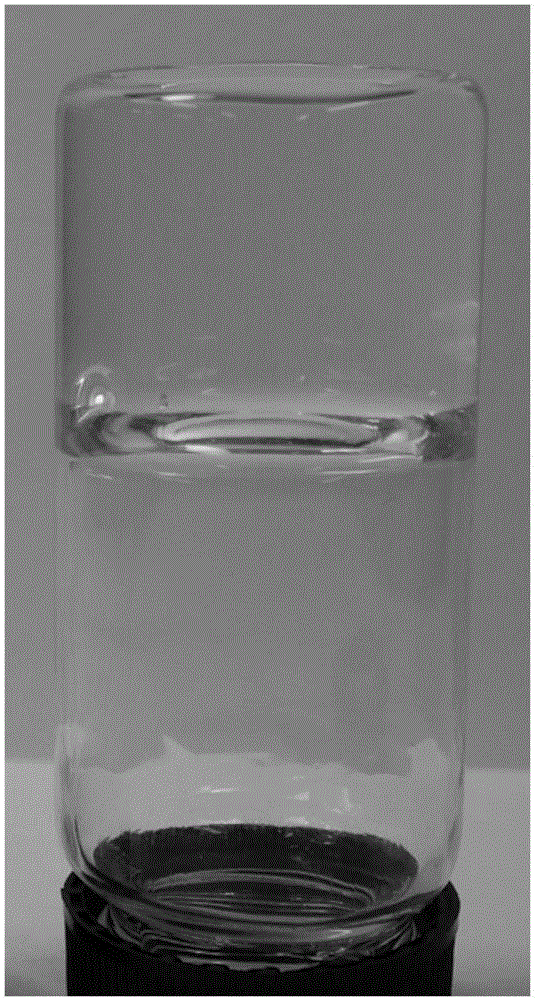Gel dressing based on G-quadruplex/collagen, as well as preparation and application of gel dressing
A collagen and quadruplet technology, applied in bandages, absorbent pads, medical science and other directions, can solve the problems of complicated preparation of gel dressings, poor biocompatibility, long healing time, etc., and achieve accelerated wound healing and strong adhesion. , the effect of non-toxic side effects
- Summary
- Abstract
- Description
- Claims
- Application Information
AI Technical Summary
Problems solved by technology
Method used
Image
Examples
Embodiment 1
[0047] (1) Add guanosine, boric acid and potassium hydroxide into deionized water at a molar ratio of 1:1:1, shake for 5 minutes, heat the water bath to 90°C, and keep the temperature for 20 minutes until the guanosine is completely dissolved .
[0048] (2) Slowly cool the above solution to 37°C, keep the water bath at a constant temperature, add collagen to make the concentration of collagen in the solution 5mg / mL, shake it to make it disperse quickly, cool to room temperature, and prepare the G-quadruple Body / collagen gel dressing.
Embodiment 2
[0050] (1) Add guanosine, boric acid and potassium hydroxide into deionized water at a molar ratio of 2:1:1, shake for 10 minutes, heat the water bath to 95°C, and keep the constant temperature for 15 minutes until the guanosine is completely dissolve.
[0051] (2) Slowly cool the above solution to 40°C, keep the water bath at a constant temperature, add collagen so that the concentration of collagen in the solution is 7 mg / mL, shake it to disperse it quickly, and cool it to room temperature to prepare the G-based - Tetrad / collagen gel dressing. Prepared gel see figure 2 shown. When the prepared gel is placed upside down, the gel will stick to the bottle wall, unlike the aqueous solution that will flow down; and after 15 days, the gel will still stick to the bottle wall when placed upside down. This illustrates the good mechanical properties of the G-tetrad / collagen based gel dressing.
Embodiment 3
[0053] The gel prepared in Experimental Example 2 was used for wound healing of mice as a treatment group.
[0054]In this experiment, a traumatic scar model was made on the back of ICR mice by surgical method. By applying the gel on the surface of the wound, observe the healing of the surface scars every day, and evaluate the repairing effect of the product on the scars.
[0055] (1) modeling
[0056] Under anesthesia by intraperitoneal injection of 1% pentobarbital sodium 5mL / kg, the back of the mouse was sheared, depilated with 4% sodium sulfide, and a circular incision with a diameter of about 1.5 cm was made on both sides of the parallel spine. If there is slight bleeding, wipe the mouse with a sterile cotton ball to stop the bleeding, and return it to the mouse box.
[0057] (2) Animal grouping
[0058] The successfully modeled ICR mice were randomly divided into groups a, b, and c, with 3 mice in each group.
[0059] A control group: the wound on the right side of t...
PUM
 Login to View More
Login to View More Abstract
Description
Claims
Application Information
 Login to View More
Login to View More - R&D
- Intellectual Property
- Life Sciences
- Materials
- Tech Scout
- Unparalleled Data Quality
- Higher Quality Content
- 60% Fewer Hallucinations
Browse by: Latest US Patents, China's latest patents, Technical Efficacy Thesaurus, Application Domain, Technology Topic, Popular Technical Reports.
© 2025 PatSnap. All rights reserved.Legal|Privacy policy|Modern Slavery Act Transparency Statement|Sitemap|About US| Contact US: help@patsnap.com



